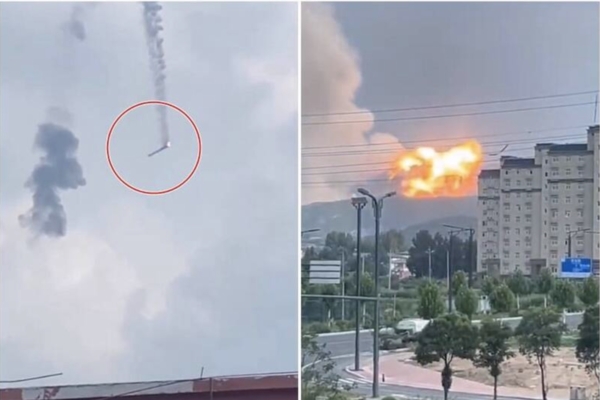Recently, the incident of the failed test of China’s “Tianlong-3” carrier rocket and the debris falling in the mountains has sparked international attention. Experts have pointed out that launch failures are not uncommon, but the use of dangerous solid propellants by Chinese companies, as well as launching from inland sites, poses risks to the public.
On June 30, China’s private aerospace company Space Pioneer conducted a static test of the propulsion system of its new “Tianlong-3” carrier rocket. During the analysis of its thrusters, the rocket, which was supposed to stay on the launch pad, unexpectedly took off and exploded. The rocket’s remnants eventually fell in the mountains of Gongyi City, Henan Province. Numerous videos show that burning rocket parts fell dangerously close to civilian infrastructure.
This incident has caused a stir both domestically and internationally. In a report on July 7, the UK’s Telegraph quoted Chris Quilty, founder of space research company Quilty Analytics, as saying that “launch failures are not uncommon,” but what is shocking is the use of dangerous solid propellants by China and launching from inland sites instead of the coastline like most non-communist countries. Launching from the coastline would ensure debris falls into the ocean “instead of on your own people.”
In addition to the launch site, experts have pointed out that China’s rocket fuels pose a threat to health.
China’s rockets have traditionally relied on hazardous fuels such as nitrogen tetroxide (N2O4), unsymmetrical dimethylhydrazine (UDMH), and red fuming nitric acid. These compounds form a highly efficient propellant but also possess toxic and carcinogenic properties. When these fuels burn, they emit a distinctive, dirty reddish-brown color.
To some extent, China’s rocket fuels can be traced back to the technology deployed on intercontinental ballistic missiles during the Cold War. The fuels are relatively stable, easy to store, and do not require “chilling” before launch. However, the byproducts can be deadly.
The Telegraph cited Rob Adlard from UK rocket company Gravitilab, stating that red fuming nitric acid is indeed terrible. Looking at the photos from China, he remarked, “My God, I can’t believe they’re doing this!”
Adlard referred to the recent incident of debris falling from the “Tianlong-3” carrier rocket, emphasizing that people in proximity to nitric acid would typically wear full protective suits in the West.
John D. Clark, author of the unofficial history book on liquid rocket propellants “Ignition,” wrote that red fuming nitric acid “attacks the skin and flesh like a group of piranhas.”
In the 1940s, American rocket scientists conducted experiments with these dangerous chemicals, earning the nickname “Suicide Squad.” One young scientist among them was Qian Xuesen, who later led China’s space program.
Subsequently, most Western rocket companies have shifted towards using less toxic kerosene and liquid oxygen, with some developing more environmentally friendly sources. SpaceX has utilized methane in its latest “Raptor” engine, which produces relatively fewer emissions compared to other fuels.
Gravitilab is developing a hybrid rocket system claiming to reduce greenhouse gas emissions by 75%. Adlard described observing China’s rocket program as witnessing a “parallel universe.” “What they are doing is completely unacceptable,” he remarked.
While Space Pioneer released a statement post-incident claiming the test site was far from Gongyi city center, it failed to appease some individuals’ anger. Netizens left comments expressing disbelief, “Is this considered far from the city center? Are we blind?” “Such an unprecedented incident in the history of aerospace! The Tianlong-3 rocket conducted a full-system hot test in Gongyi, Henan, resulting in the rocket flying out directly and exploding so close to residential areas. This should make international headlines!”
Simultaneously, the international community has not forgotten the 1996 Long March 3B rocket launch failure. During this incident, it was evident that significant issues arose shortly after ignition. The rocket violently tilted to the left, exploded 22 seconds after launch, producing a huge fireball, with debris and burning fuel scattered near a village close to the Xichang launch center.
Public records indicate that the explosion estimated to have a power equivalent to 55.6 tons of TNT, damaging over eighty residential buildings. While the Chinese official statement mentioned 6 deaths and 57 injuries, the Telegraph reported that US defense officials estimated the actual figures to be in hundreds.
The report stated the 1996 disaster prompted American space companies to hastily withdraw from cooperation with China, effectively leading to the strict export control system still in place today.

